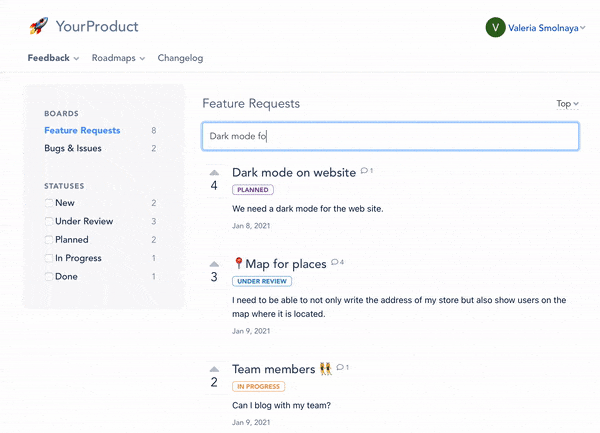User Feedback Tool
Customer experience is what makes up a large part of the success of most companies. More than 85% of companies actively working to improve customer experience report an increase in revenue.
A great start to improving experience for your product would be to use a customer feedback tool. By understanding how users feel about your product and what their real needs are, you can optimize improvements to your product.

After reading this article you will learn something new about working with user feedback.
Why you need to work with user feedback
Companies that work successfully with feedback cite these three main reasons.
1. Know your customers' needs
Your product may be good, but the world is changing rapidly, and with it, users have new needs. By being able to get feedback directly from customers, you can understand their needs quickly and make the necessary changes ahead of the competition, thereby making your product more attractive than others.
2. Improve your product or service
Companies spend a lot of money on market research, surveys, and competitor research. By organizing the collection of feedback from customers, you get all this information from the primary source - your customers. And you can also identify the most active users, very often people who actively provide feedback become beta-testers or promoters of your product.
3. Reduce customer churn
Using the feedback system you can collect feedback from dissatisfied users, such as bugs or errors in your product. Confirming and fixing such problems in time will reduce customer churn and increase retention.
What is a user feedback tool?
User feedback tool is a user engagement tool that allows you to efficiently collect feedback, process it, store it, and further communicate with the user who provided that feedback.
How feedback tool can help business?
From the company's point of view, such tools automate the work with feedback. From the user's point of view, there is ownership in the work on the product, and the mental distance between the user and the product team is reduced.
There are also some other non-obvious at first glance benefits of using special tools for working with feedback:
Feature requests prioritization
By collecting product ideas in one place, it's easy to see what users are voting for. Some users may want the same features but call them differently, in which case you can combine them into one.
Empowering internal teams to share product feedback
In feedback management tools, the team communicates directly with users, which increases trust and transparency.
In addition, team members can make suggestions for product development on an equal footing with users and immediately see feedback from users in the form of votes for their ideas. Such interaction increases team involvement, because all people want to do things that someone needs, and no one wants to do useless features.
What additional functions must a customer feedback tool have?
All products are evolving and we gathered user feedback (using Productroad, of course) to see what would be nice to have in a feedback tool.
Keeping everyone engaged with product updates
It is not only important to collect feedback and do something with it, but also to inform the user about it.
The user may not use your product, waiting for a feature to be added and not know about the update, or they may report a minor bug that they will even forget about. In the first case it is simply necessary to inform the user, in the second - it will be a nice little thing that will create a pleasant impression about your product.
Our tool has the ability to change the statuses for feedback posts (you can set them up yourself), and when you change the statuses you choose whether or not to send notifications to users who have signed up for updates.
Integrations to product ecosystem
As a rule, companies think about collecting feedback after the first users appear, while many tools, such as team messenger, appear at the stage of product development.
The feedback tool must integrate and work in conjunction with the rest of the company's tools. To do this we have direct integrations, such as the ability to be notified of new feedback in Slack.
Many users ask for tools to automate workflow, the most popular tool being Zapier.
However, most mid-sized companies prefer direct integrations using API.
Internal feedback for employees
You can use feedback not only to interact with users, but also to interact with the whole team.
What technologies to use? What went wrong in this sprint and what worries you the most? How do you set up the office (okay, not relevant anymore, everything is remote)?
All of this can be discussed by creating closed feedback boards and getting honest and open feedback from employees, and the ability to vote will identify the most important issues.
Can a good user feedback tools be free of charge?
We believe in helping new products, so we created a special free plan. It's free until the first 50 users are active on the feedback portal.
Considering that usually not more than 5-10% of users leave feedback, you should have more than 500 users before we ask you to upgrade your plan.
Not bad to start with?
Productroad helps you collect user feedback, prioritize it, make a roadmap of a project and inform customers via changelog about new cool features.